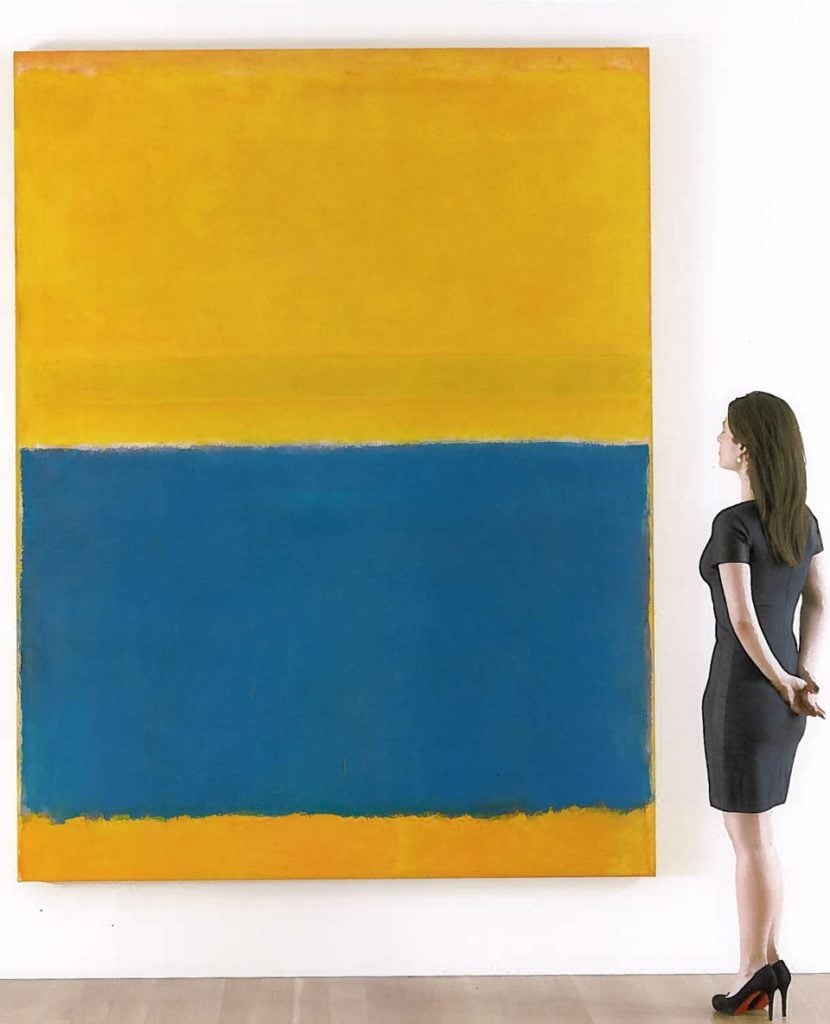Auctions
10 Instances of Auction House Promotional Hyperbole, Ranked
Read how the auction catalogues are pimping Rothko and Twombly this week.

Read how the auction catalogues are pimping Rothko and Twombly this week.

Brian Boucher

As we head into what may be the biggest week of auctions ever held in New York, with billions of dollars’ worth of art on offer at Christie’s, Sotheby’s, and Phillips, artnet News has been poring over the gigantic promotional catalogues the houses send their clients.
See Will Twombly, Freud, and Rothko Lead Christie’s to A Billion-Dollar Night? and Is Christie’s Abandoning the Impressionism and Modern Art Market?
The catalogue for Sotheby’s upcoming contemporary art sale caused artnet’s postal scale to throw up its hands when we tried to weigh it. Too heavy, the machine said.
For the first time, Sotheby’s has even included pictures of pretty ladies standing in front of the artworks, indicating the works’ sizes while hoping to add sex appeal. (Except for the girl, it’s also just like that “in-room” feature on Amazon art!)
Promotional copy is what it is, but the vanity essays on individual works can be pretty hilarious. Every iconic artwork, it seems, boldly represents a pinnacle of the seminal artist’s glorious achievements from a pivotal period in his (let’s be real, it’s generally his) storied career. Sometimes the words don’t even make sense in the order they put them in, honestly.
A few years ago, the writer Alice Gregory went behind the scenes at Sotheby’s and offered an inside view, in n+1’s winter 2012 issue, of how the sausage gets made. It’s worth a read.
We’ve read these essays so you don’t have to, and here we offer the 10 best examples from the paeans pimping the top works from this week’s sales (and one from last week’s), ranked, from mildest to frothiest.
On an untitled Cy Twombly:
The magisterial sweep of Cy Twombly’s enigmatic mark-making in Untitled marks a radical shift in the artist’s unique painterly style.
On Mark Rothko’s No. 10:
Mark Rothko’s No. 10 represents the pinnacle of his alchemical prowess. … [It comes from] a body of work that has been held up to be the pinnacle of Rothko’s career, the true manifestation of Rothko’s artistic rasion-d’etre.
On Sigmar Polke’s Dschungel:
With the porous phantasmagoria of iridescent dots constituting Dschungel, Polke beckons an instant longing that is quickly thwarted by the impossibility to see clearly, aesthetically capturing the sensation of desire and concomitant absence of fulfillment characteristic to the consumer society of West Germany.
On Robert Ryman’s Note:
Robert Ryman’s Note from 1998 bristles with an unrivaled dynamism and a clear vitality that renders it a timeless explication of the very essence of beauty.
On Mark Rothko’s Untitled (Yellow and Blue), as part of a 20-page essay:
Executed in 1954, at the chronological apex of the celebrated period of Rothko’s career referred to by David Anfam, author of the artist’s catalogue raisonée, as the anni mirabilis, Untitled (Yellow and Blue) is a triumphant archetype of this artistic ideal: its radiant surface and towering scale elicit a visual and somatic experience that is prodigious and undeniable, compelling us to surrender to a sense of pure contemplation in the face of its painterly authority. (That sentence is 76 words!)
On Roy Lichtenstein’s The Ring (Engagement):
At an exceptionally impressive scale that magnifies the instant of proposal to epic proportions, while evoking the cinematic frame of a comic strip in its sprawling horizontality, The Ring (Engagement) is explosive in dynamism and elemental force, gripping each viewer in its pictorial exuberance and conceptual gravitas. … With the painting’s simply radiant intensity and cinematic vitality, Lichtenstein ensured that the only answer to his proposal is an unequivocal yes.
On Jean-Michel Basquiat’s World Crown:
Loaded with a complex network of ideas, stunning in both its execution as a painting and as a vehicle for the many tributaries of thought that inform Basquiat’s process, World Crown is outstanding as one of the most visually compelling and irresistibly animated of the artist’s works: a bravura exhibition of painting and graffiti mark-making that leaves the viewer simply spellbound.
On Vincent van Gogh’s L’Allée des Alyscamps:
A majestic allée at the peak of its autumnal splendor is the subject of Van Gogh’s magnificent L’Allée des Alyscamps ... This was the very moment in Van Gogh’s career when his most legendary expressions of great beauty and exuberance were captured on canvas. Works such as Sunflowers, Self-Portrait, L’Arlesienne, the Night Café, The Sower and the postman Monsieur Roulin were all brilliantly realized with unparalleled creative force during this period, and the unrestrained passion of this artistic genius was at its apotheosis.
On Lucian Freud’s Benefits Supervisor Resting:
This painting is a triumph of the human spirit.
I don’t know about you, but that last one, for me, is truly a triumph of the human spirit. Cue the swelling strings, guys, and I’ll see you at the sale.